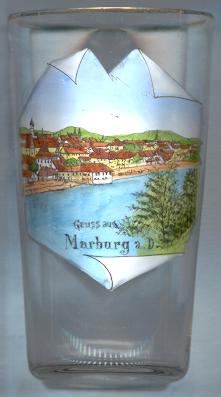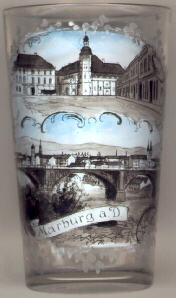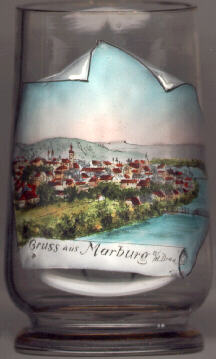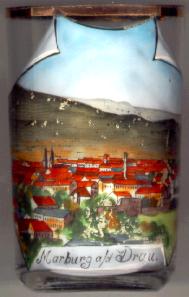

|
| SLOVENIJA | SLOVENIA |
| regija: Podravska |
 The earliest mentioning of Maribor (as Marchburch) dates back
to 1164. A fortress was built on a hill in the vicinity of the Drava river
in order to guard the border of the Holy Roman Empire of German Nation against Hungary.
The settlement obtained the rights of a market in 1204 and of
a town in 1254 and became an important trading place for wood, wheat and wine.
An important factor for the economical life of the town were the Jews who lived
in the ghetto around the synagogue. The jewish community of Maribor was one of the
largest in the country until their expulsion in 1497. The synagogue and other
parts of the ghetto are well preserved and can still be seen today.
The economical position of the town was weakened in the following centuries
due to the invasions of the Hungarians and the Turks, and also by epidemias
such as the plague. The plague of 1680 reduced the population by one third.
In the course of the 18th century trading began to flourish again when new
roads connected Vienna with the harbour of
Trieste. In the late 18th and early 19th century
the textile industry caused a further growth of the city and large parts of the old
town fortifications were torn down. In 1846 the new railway line from Vienna to
Graz and Trieste was opened. Nevertheless, the city always
remained second to Graz, the capital of the old Duchy of Styria. The early 18th
century also brought a boost for the self-confidence of the Slovene population
of Maribor (this slovene name came into use from about 1836). With the break-up
of the Austro-Hungarian Monarchy in 1918 and the Treaty of Paris/St. Germain 1919
the southern parts of Styria with Maribor as the main city became part of the
Kingdom of Serbs, Croats and Slovenes.
German troops occupied the country in 1941 and started a cruel Germanization which ended
in 1945 when Slovenia became part of Yugoslavia. The importance of Maribor
as Slovenia's second city was underlined by the opening of the university of Maribor in 1975.
Together with Guimarães (Portugal), Maribor was selected to be European Capital of Culture for 2012.
The earliest mentioning of Maribor (as Marchburch) dates back
to 1164. A fortress was built on a hill in the vicinity of the Drava river
in order to guard the border of the Holy Roman Empire of German Nation against Hungary.
The settlement obtained the rights of a market in 1204 and of
a town in 1254 and became an important trading place for wood, wheat and wine.
An important factor for the economical life of the town were the Jews who lived
in the ghetto around the synagogue. The jewish community of Maribor was one of the
largest in the country until their expulsion in 1497. The synagogue and other
parts of the ghetto are well preserved and can still be seen today.
The economical position of the town was weakened in the following centuries
due to the invasions of the Hungarians and the Turks, and also by epidemias
such as the plague. The plague of 1680 reduced the population by one third.
In the course of the 18th century trading began to flourish again when new
roads connected Vienna with the harbour of
Trieste. In the late 18th and early 19th century
the textile industry caused a further growth of the city and large parts of the old
town fortifications were torn down. In 1846 the new railway line from Vienna to
Graz and Trieste was opened. Nevertheless, the city always
remained second to Graz, the capital of the old Duchy of Styria. The early 18th
century also brought a boost for the self-confidence of the Slovene population
of Maribor (this slovene name came into use from about 1836). With the break-up
of the Austro-Hungarian Monarchy in 1918 and the Treaty of Paris/St. Germain 1919
the southern parts of Styria with Maribor as the main city became part of the
Kingdom of Serbs, Croats and Slovenes.
German troops occupied the country in 1941 and started a cruel Germanization which ended
in 1945 when Slovenia became part of Yugoslavia. The importance of Maribor
as Slovenia's second city was underlined by the opening of the university of Maribor in 1975.
Together with Guimarães (Portugal), Maribor was selected to be European Capital of Culture for 2012.

The  castle [left: top]
in the northeastern part of the old town was built by Emperor Friedrich III in 1478.
Between 1532 and 1933 it served as noble residence.
After the Turkish siege of 1532, the castle was fortified by the Italian
master-builder Domenico dell' Allio (1556–1562). The Laurentine chapel
[the small building on the left side of the tower] was
erected in 1655. Between 1741 and 1750, the grand staircase in Rococo style
was added. The central part of the castle is the Festival Hall, also called
'Knight's Hall'. The oval ceiling of the hall is decorated by a monumental
painting of 1763 showing the battle between the Christian and Turkish armies.
Since 1938 it houses the regional museum.
castle [left: top]
in the northeastern part of the old town was built by Emperor Friedrich III in 1478.
Between 1532 and 1933 it served as noble residence.
After the Turkish siege of 1532, the castle was fortified by the Italian
master-builder Domenico dell' Allio (1556–1562). The Laurentine chapel
[the small building on the left side of the tower] was
erected in 1655. Between 1741 and 1750, the grand staircase in Rococo style
was added. The central part of the castle is the Festival Hall, also called
'Knight's Hall'. The oval ceiling of the hall is decorated by a monumental
painting of 1763 showing the battle between the Christian and Turkish armies.
Since 1938 it houses the regional museum.
The  old bridge [left: bottom]
spanning the river Drava was built in 1913 and still is in use today.
old bridge [left: bottom]
spanning the river Drava was built in 1913 and still is in use today.


![[scale]](lineal.jpg)